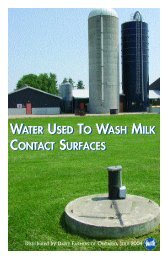Canadian Quality Milk On-Farm Food Safety Program - Centre ...
Canadian Quality Milk On-Farm Food Safety Program - Centre ...
Canadian Quality Milk On-Farm Food Safety Program - Centre ...
Create successful ePaper yourself
Turn your PDF publications into a flip-book with our unique Google optimized e-Paper software.
<strong>Canadian</strong> <strong>Quality</strong> <strong>Milk</strong><br />
HAZARD SOURCE BEST MANAGEMENT PRACTICES<br />
Bacteria in milk -<br />
microbes on milk contact<br />
surfaces<br />
• Malfunctioning<br />
equipment<br />
• Water supply<br />
contaminated with<br />
pathogenic bacteria<br />
effecting milking<br />
equipment sanitation<br />
Have written plans outlining how to deal with<br />
a situation when:<br />
• <strong>Milk</strong> contact surfaces are found to be dirty.<br />
• Pre-rinse or wash water is not the correct<br />
temperature.<br />
Check and record pre-rinse water (weekly) or<br />
wash water (monthly)<br />
Have wash system evaluated annually.<br />
Keep milk house and external surfaces of<br />
milking equipment clean.<br />
Check detergent concentration regularly.<br />
Check slugging action during equipment<br />
maintenance check.<br />
Check timing of cleaning system during<br />
equipment maintenance check.<br />
See Chapter 11 and Workbook Chapter C.<br />
Test water supply for provincial<br />
microbiological parameters annually.<br />
Ensure water meets provincial standards for<br />
bacteria.<br />
Have a written plan to deal with a situation<br />
where water is shown to be contaminated.<br />
Contamination of milk<br />
with chemical residues<br />
• Dirty bulk truck milk<br />
transfer hose<br />
• Cleaning solutions<br />
CHEMICAL<br />
• Pesticides (e.g.<br />
insecticides and<br />
rodenticides)<br />
• Overuse of cleaning<br />
products<br />
• Incomplete drainage<br />
of milking equipment<br />
(milk pipelines,<br />
receiver jar and bulk<br />
tank)<br />
• Improper storage of<br />
chemicals<br />
• Faulty safety switch<br />
Keep milk loading area free of manure<br />
contamination.<br />
Equip hose port with tight-fitting door or selfclosing<br />
cover.<br />
Maintain a concrete or crushed stone apron<br />
outside the milk house directly under the<br />
hose port that is large enough to keep the<br />
milk hose off the ground and clean.<br />
Use approved products according to<br />
accessible cleaning and sanitizing chart.<br />
Install a safety switch or fail safe system or<br />
check function of existing one.<br />
Have wash system evaluated annually.<br />
Store chemicals in a location and manner<br />
that will not contaminate milk or meat.<br />
Store in properly identified and labeled<br />
containers.<br />
Use milk house exclusively for cooling and<br />
storing milk and for cleaning, sanitizing and<br />
storing materials and equipment used in the<br />
production and handling of milk.<br />
June 2010 7—15
















